Applications
At IfA we strive to apply theory to practical application domains, and so we pursue applied research on real control problems in different areas. This frequently involves cooperating with industrial partners to develop solutions to their problems.
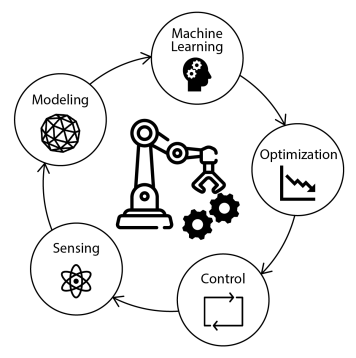
The availability and ease of integration of sensors opens the possibility of utilizing additional data to monitor and control industrial processes for the optimization of processing time and quality. Our group’s research focuses on the integration of advanced control methods in combination with statistical and machine learning insights in industrial equipment. Systems of increased complexity can be controlled using data-driven methods to model their processes without full knowledge of their mathematical representation. Models can be updated with data-based algorithms for learning unmodelled effects during operation. Such methods have been demonstrated in the field of robotics, but have not been widely applied and adapted for implementation in manufacturing. We are currently working on several projects on the intersection between simulation, machine-learning algorithms, model predictive control and statistical methods: plasma spraying optimization, productivity maximization for machine tools and advanced control for precision machining and additive manufacturing. Our approaches are interesting both from a practical point of view – providing enhanced performance of the machines – and from the research point of view: the general questions posed by our applications allow us to explore and design new methods of data-based control. This line of research is part of a long-standing collaboration between inspire AG and the Automatic Control Laboratory. More
Power electronics

Power electronics deals with controlled electrical energy conversion. Two key aspects that characterize the performance of a power conversion system are its efficiency of the conversion and its dynamic performance. By dynamic performance, it is meant how fast the power conversion system can adapt to fluctuations and also how efficient is the efficiency during fluctuations. As power conversion systems operate from below the kHz to above the MHz, another crucial aspect is the real-time performance. Our research deals with the optimization of the static and dynamic performance of power conversion systems using advanced modelling, optimization and control techniques as well as real-time implementation of these solutions. More
Control of electrical drives
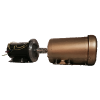
The optimization of the operations of electrical drives is a topic of paramount importance when considering energy efficiency of industrial plants. An electrical drive consists of a converter and a motor: this architecture allows one for variable speed control of these machines. These devices convert the electric energy from the grid into mechanical energy in the load. The goal of the research activity is the minimization of the power losses in the transformation. In particular, we focus on accurate modeling and control based on mathematical optimization to improve the performance of the drive. The activity is in the framework of the Energy SmartOps project. More
Air traffic control

The primary concern of Air Traffic Control (ATC) is to maintain safe separation between the aircraft in the airspace. ATC is currently very much a human-in-the-loop process, with air traffic controllers ultimately responsible for safety. The aim of our research in this area is to facilitate the work of human controllers by introducing automation and decision support tools, based on modeling, estimation, distributed control, and optimization methods. More
Networked control systems

Networked control systems consist of many spatially distributed sensors, actuators, and processors that can communicate with one another over a wired or wireless computer network. Rapid advances in sensing technologies are revealing unprecedented dynamic data streams about diverse physical, technological, and social network dynamics, and new actuation technologies are increasing the ability to manipulate network architecture and dynamics. Traditional methods from control theory are not suitable for analyzing and designing such networks due to computational complexity and inability to deal with constraints imposed by the network such as structural information flow constraints, data loss and corruption, bandwidth limits, and variable delays. Research in this area brings together results from control, optimization, information and communication theory, computer science, data mining and statistics, and others to form a theoretical foundation. More
Chemical processes
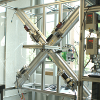
The chemical industry, a pillar of the world economy, has been known to profit from modern control techniques, such as model predictive control, for decades; however, the complex and highly nonlinear nature of certain processes has so far eluded useful quantitative description and hence has been difficult to control. The field of separation processes contains many such problems, and in recent years, the automatic control laboratory has focused its efforts on these types of systems: Apart from several contributions in the field of chromatography, in particular the control of simulated moving bed (SMB) processes, research is mostly connected to the CrystOCAM project. More
Flight control
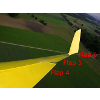
This interdisciplinary research project focuses on assessing the potential of wing morphing in improving the characteristics of airplanes. Conventional rigid-wing airplane designs are the result of a tradeoff between different requirements arising from diverse operating points within their typical mission. Morphing wings have the potential of adapting to different flight conditions in an optimal way (e.g. minimal drag at each operating point). The research carried out at the Automatic Control Lab as part of this project consists of parameter identification from free flight data, closed-loop control of Macro Fiber Piezo actuators, attitude stabilization for a flying wing and aims at showcasing closed-loop control of the span-wise lift-distribution on a 3m-span flying wing prototype with smart actuators integrated in a selectively compliant lifting surface. More
Bio systems
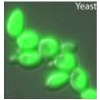
Biochemical reaction networks can be understood and controlled with the help of stochastic models. These models have to be identified from measurements of the abundance of chemical compounds inside single cells. For a successful identification it is usually critical to perturb the system in order to induce dynamic changes in the molecule abundances. These perturbations can be planned such that they optimally excite the system and lead to maximally informative data. More
Swiss free electron laser
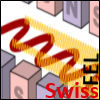
In a free-electron laser (FEL), the accelerated electron beam is passed through a periodic magnet array, called undulator, causing transverse acceleration of the electrons which results in the release of photons. The SwissFEL project at Paul Scherrer Institute will develop a free-electron laser which provides a source of very bright and short X-ray pulses. The major control contributions are in the area of: RF system modeling and identification; repetitive robust control theory; repetitive learning algorithms; and distributed control and information architectures for high performance systems. More
Thermoacoustic machines
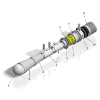
Thermoacoustics deals with reversible energy conversion and interaction between heat oscillations and sound waves in gases and involves research in acoustic, thermodynamic, fluid dynamical phenomena and system dynamics. Thermoacoustic machines convert fluctuating low grade thermal energy into sound waves of high amplitude which in turn can drive thermoacoustic refrigerators and heat pumps or can be directly converted into electrical energy using an electrodynamic or piezoelectric transduction mechanism. Such machines have a high potential for the development of sustainable and alternative energy systems by utilizing low temperature waste heat recovery, biomass and gas combustion heat and solar energy, respectively. Promising features of thermoacoustic machines are high reliability, lack of moving parts (with the exception of the acoustic resonator), quietness, low cost and generally environmental friendliness. More
Digital fabrication
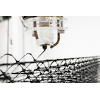
This project investigates the use of robotics in architecture and construction. Our objectives are to design and analyse control systems for cooperative robots engaged in building construction. These robotic systems will allow the construction of architectural designs that are not currently possible due to cost or precision constraints. More
Active noise control
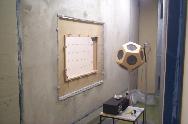
Noise is more and more perceived as an environmental pollutant. This shift in attitude is reflected in stricter legislation and has wide ranging economic consequences. Traditionally, noise was reduced by passive means like mufflers, damping plates, sound absorbing materials, double-glazing windows, noise barriers etc. All these passive means are mostly suitable for high frequencies and have various disadvantages. In the last decade, active control of sound and vibration (at audio frequencies) has emerged as a viable technology to bridge the low-frequency technology gap. More
Anesthesia
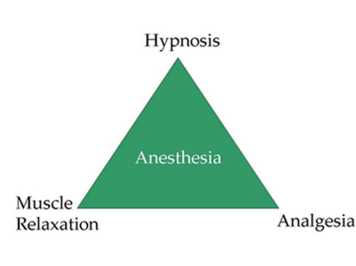
Over the past years our group has developed different model-based controllers for ventilation, blood pressure, depth of anesthesia and muscular relaxation (Former Projects). However, the major issue of controlling patient's analgesia is still open. Current research focuses on providing adequate analgesia during surgery, in the postoperative setting and for conscious sedation. More